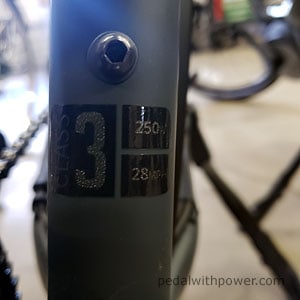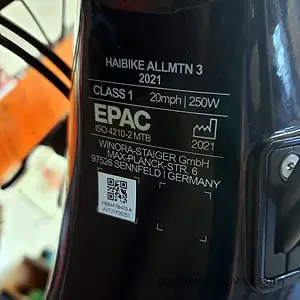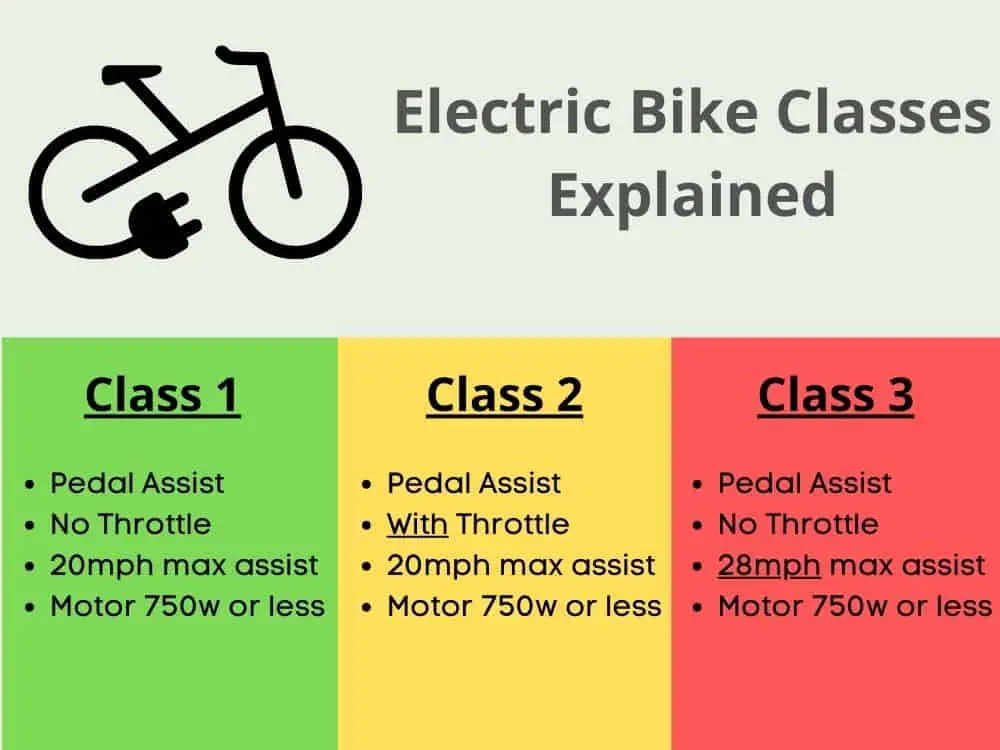Electric bikes are defined by different classes in order to differentiate them from mopeds and electric motorcycles. Your ebike has a certain “class” that it needs to fall under in order to be street legal, and need no license, insurance, or registration.
Your ebike is either a class 1, 2, or 3, if it’s street legal, and this is very important to know because some places will allow a class 1 and not a 2 or 3. There are also different regulations depending on which class your ebike is.
Quickly Ride to a Section -
What Are the 3 Ebike Classes?
In the United States, these are the 3 ways an electric bike can be classified –
- Class 1 – Pedal-assist only – no throttle – up to 20mph – max motor wattage 750w
- Class 2 – Pedal-assist with a throttle, up to 20 mph – max motor wattage 750w
- Class 3 – Pedal-assist only – no throttle – up to 28mph – max motor wattage 750w
Here is a link to the People For Bikes PDF explaining this –
All three classes need to have a working speedometer and be able to be ridden like a regular bike, with the motor off.
As long as your ebike falls into one of these three classes you are good to go. Most ebikes sold in the US are one of these 3 classes.
What Is a Class 1 Electric Bike?
A Class 1 electric bike is a pedal-assist only ebike with no throttle and a motor rated at 750w or below that will stop assisting at 20pmh. It also needs to have a working speedometer!
This is the perfect electric bike for those of you that want to get some exercise and have a blast while doing it!
The current ebike that I ride the most is a class 1, mid-drive, and I find that it is the perfect balance of speed and pedaling to get where I want to go and get some exercise too.
Most trail systems and parks (National & State) that allow electric bikes, only tend to allow Class 1 ebikes. Some National and State parks will allow Class 2 ebikes as long as you don’t use the throttle. Few will allow Class 3’s or they may have restricted rules for them.
For more information about different Class restrictions –> “Where Can You Ride an Electric Bike?”
What Is a Class 2 Electric Bike?
A Class 2 electric bike is any ebike with a throttle and pedal-assist, that has a 750w motor or less and will stop assisting at 20mph. This also needs a working speedometer!
Class 2 ebikes are usually hub drive electric bikes (though there are some mid-drive class 2’s) and are what most of the online ebikes are. (Rad Power, Lectric, Aventon, etc.)
These will typically be for folks that don’t ride a whole lot already or just want to get back into riding again.
Having a throttle to help you out can give you some confidence to get you riding again. You will still want to pedal a bit and you will find yourself pedaling more and more as you ride further.
The intention of the throttle is just to help get you up to speed or to get through an intersection, these throttle-style ebikes are not designed to be ridden primarily using the throttle.
Now that I have a Class 2 ebike (Lectric XP 2.0) I can tell that the throttle only provides a little bit of power and to get the most out of the bike you will want to pedal also.
What Is a Class 3 Electric Bike?
A Class 3 electric bike is a pedal-assist only, no throttle ebike with a 750w or less motor that will stop assisting at 28mph. This class needs a working speedometer!
Class 3 ebikes are for those of you that really need to get where you are going in a hurry.
With a class 3 ebike, the motor will continue to assist you until you get going faster than 28pmh, which is pretty fast on a bike. Generally, you will need to be going downhill to reach these speeds.
Keep in mind that these class 3 ebike are pedal-assist only and you will need to be pedaling and contributing enough of your own power to keep going that fast.
You can definitely get a good workout on one of these, but Class 3’s are for the more experienced rider.
My first electric bike was a Class 3 and it was definitely fun, but I noticed that because the motor will keep helping up to 28pmh, it got far less range than my current Class 1, even with the same size battery. So keep that in mind!
I would not recommend a Class 3 if you don’t already do a lot of bike riding. Navigating safely at speeds above 20pmh takes skill and can be dangerous!
What Does Pedal-Assist Mean?
Pedal-assist is when the electric motor on your ebike is helping supply a percentage of the power when you pedal, to increase your efficiency and propel you forward without you having to put in as much work.
The beauty of a pedal-assist ebike is that you can now ride at whatever pace you are comfortable with and not have to sacrifice your speed and energy.
Pedal-assist allows you to set up your ebike in the most comfortable way you want. This means that you don’t have to be leaning out over the handlebars or trying to get as streamlined as possible.
Having your bike set up for comfort will allow you to go out for rides more often and not make you feel so sore afterward.
How Can I Tell What Class My Ebike Is?
The manufacturer of your ebike is required to let you know what class of ebike you are buying. Just use the above definitions or try to find the sticker on your bike.
Here is an example of what some of these stickers look like –



Another way to tell is to just go for a ride and if the motor stops helping at 20 mph, you have a Class 1 (no throttle) or Class 2 (with throttle). Easy peasy, hanky sneezy! 🙂
If your ebike is a hub drive (meaning the motor is in the rear hub) just look for the wattage on the hub. Most will be 750w or less.
Why Does It Matter What Class My Ebike Is?
It is good to know what class ebike you are on because, in some places, there may be restrictions for certain classes.
If you will be planning to take your ebike with you as you travel and ride in National Parks or campgrounds and such, I would check ahead of time and see what their rules are.
Most places these days will allow Class 1 ebikes but may restrict the use of Class 2’s and 3’s.
Some electric bikes now, like my Lectric XP 2.0, can switch between classes. You may want to check your owner’s manual or your company’s website to see if your ebike can switch classes.
Can You Change the Class of Your Ebike?
Some newer ebikes are now capable of witching between classes using the controls and display settings. Most ebikes however, will be limited to whatever Class they are and can not be changed.
I know my Lectric XP 2.0 is capable of switching between all 3 classes with a couple of setting changes. This is not some kind of hack, they programmed it to be this way and walk you through how to do it in the manual.
This could become the new normal as ebike gain popularity here in the states and more place allow them to be ridden as normal bikes.
You may want to know how to do this or if you can do this before piling up your bikes and heading off to unknown destinations.
What If My Ebike Is Not 1 of the 3 Classes?
If your ebike does not fit into 1 of these 3 classes, maybe the motor is 1000w or higher, or the motor can assist well above 28mph, then you will want to check with your state laws and may need a license, registration, and insurance to ride it on the street.
You will also want to check with your local department of motor vehicles to see if they will want brake lights, turn signals, and mirrors too.
Most of the time these unclassified ebikes (sometimes people like to say they are Class 4’s, but there is no Class 4) are still allowed off-road and you will find that many of the electric bikes designed for hunting are 1000w or more.
At the End of the Day
I hope this will relieve some of the confusion you may have had about ebike Classes and why they matter.
All 3 classes will be a lot of fun to ride, but you may want to stick to a certain one depending on your skill level, fitness level, or where you will be riding.
Just please abide by the rules of your area so that ebikes will find their place everywhere!
“Stay Classy San Diego!” – Ron Burgundy
